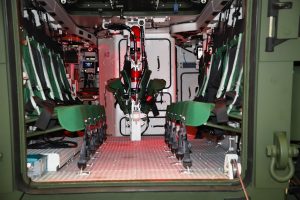
IDEF 19: FNSS unveils the ZAHA marine amphibious vehicle
“To my left you can see the prototype of our Marine Amphibious Vehicle, the programme being currently in the Critical Design Review phase, however the vehicle design is mostly completed, thus it is very similar to what will be the final version,” Nail Kurt, the FNSS CEO says opening the press conference that marks the first public appearance of the company MAV, ZAHA in its Turkish acronym standing for Zırhlı Amfibi Hücum Araçları (Armoured Amphibious Offensive Vehicle).The MAV was developed under a contract from SSB, the production contract including 27 vehicles, 23 personnel carriers, two command and control and two recovery, all to be delivered by 2021. “FNSS is the only western manufacturer that features such a type of vehicle in its portfolio,” Mr. Kurt underlines, noting the fact that the other manufacturer is one of the two partners in the FNSS joint venture, “and we have been selected for this programme thanks to our experience in amphibious vehicles.”

The MAV is a much more modern vehicle compared to its competitor, which is nearing the half century of service albeit it has been constantly upgraded, thus according to FNSS CEO the new vehicle presented at IDEF is the best of its class today in terms of “number of people transported, level of ballistic and mine protection and performance criteria on land and in water.” The MAV is 30 cm longer compared to its competitor and has more room inside, allowing transporting 21 naval infantrymen while keeping the same weight and having the same width, maximum GVW being 30 tonnes but according to FNSS officials there is still some margin as the current vehicle weight is below that mark. The greater volume should help in flotation, the MAV being capable to operate with Sea State 4 and having a self-righting capability. According to FNSS the aluminium hull has a better corrosion protection, an add-on ceramic providing a higher protection compared to upgraded competitors. Moreover the amphibious vehicle of Turkish origin was designed from scratch for mine protection, which allows reaching better protection, levels remaining classified.

The MAV is fitted with two improved waterjets at the rear allowing it to reach a maximum speed of 7 knots, 5 knots being the usual cruise speed, maximum speed over land being 70 km/h.After IDEF the MAV prototype will start company testing, which will last over one year during which some modification will be possible, the change of front shape being potentially one of those. Buoyancy, water speed and land mobility are three of the fields that might be subject to optimisation. The current prototype will soon be joined by a second one, which assembly will start in late May and which will have no mission equipment installed, as it will be used mainly for amphibious testing; these should start in lakes before moving to sea tests. Lessons learned on the two first prototypes will lead to prototype #3, which should represent the frozen configuration of the armoured personnel carrier version.

The available prototype features a remotely controlled weapon station that can be armed with a 12.7 mm machine gun and a 40 mm automatic grenade launcher and two series of four smoke grenade launchers per side; day/night situational awareness is available to the crew, which can bus or debus through the rear powered ramp with a built-in door, personnel and cargo hatches being available in the roof at the rear, the pilot and the commander having separate hatches.These two prototypes should be produced within late 2019. Next year two more prototypes will be made available, completing the series of five planned, the first being in the command and control configuration while the second will be the recovery variant.One mine blast test has already been carried out on an element of the MAV, while ballistic tests were also done against armour samples. Further testing will be carried in the next months, among which a mine blast test with the customer.

Asked about a possible second order by the Turkish Naval Forces, the FNSS CEO answered that the construction of a second LHD is currently under discussion, and should the decision be positive, then an order for further 27 MAV would be strongly possible. As for further variants, he stated that an engineer version might also see the light.“We are also in discussion with some friendly countries,” Neil Kurt said, “mostly in the Far East, some of them being already our customers while other are nations in which we are not yet present.
Photos by Paolo Valpolini



